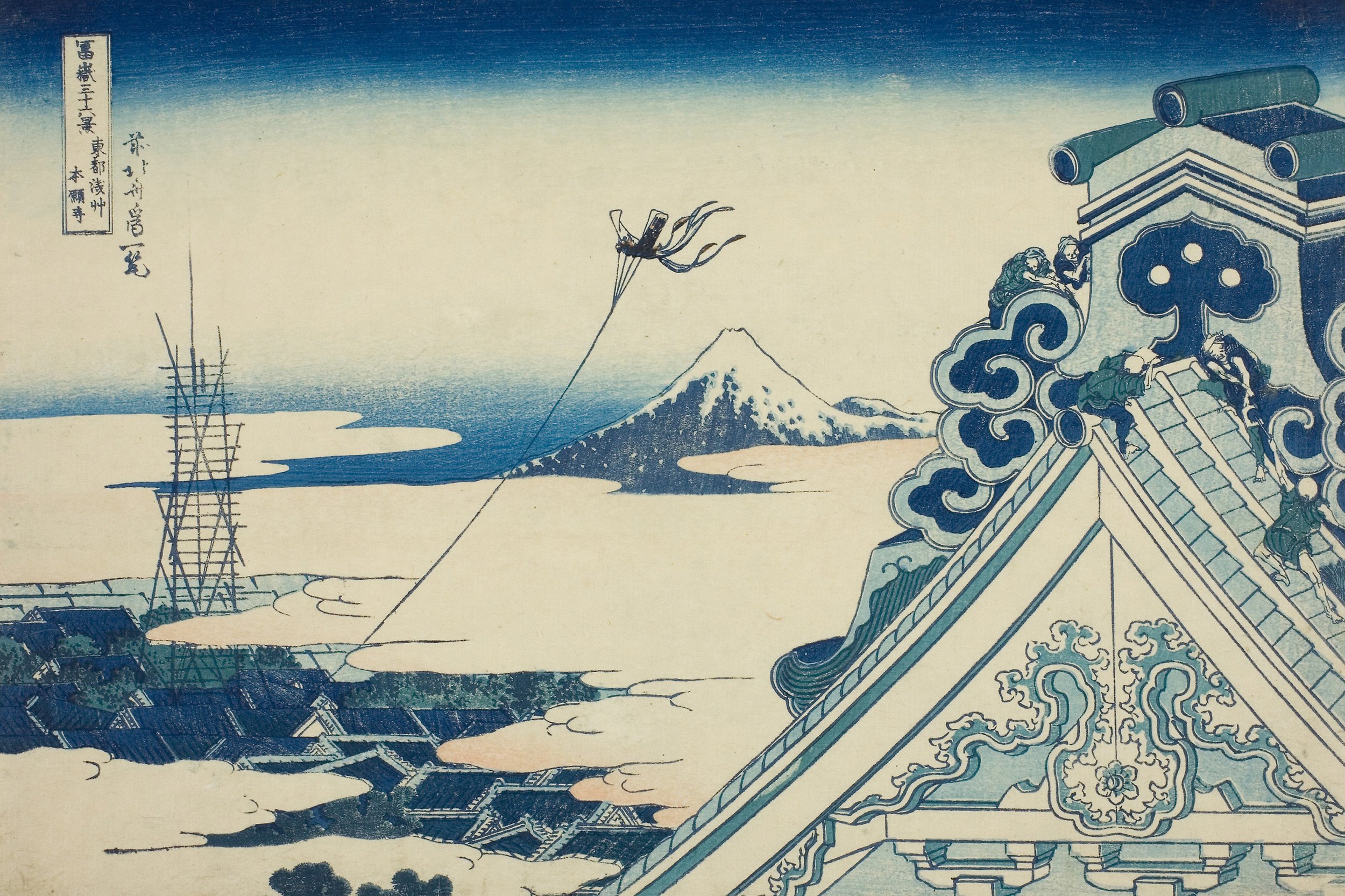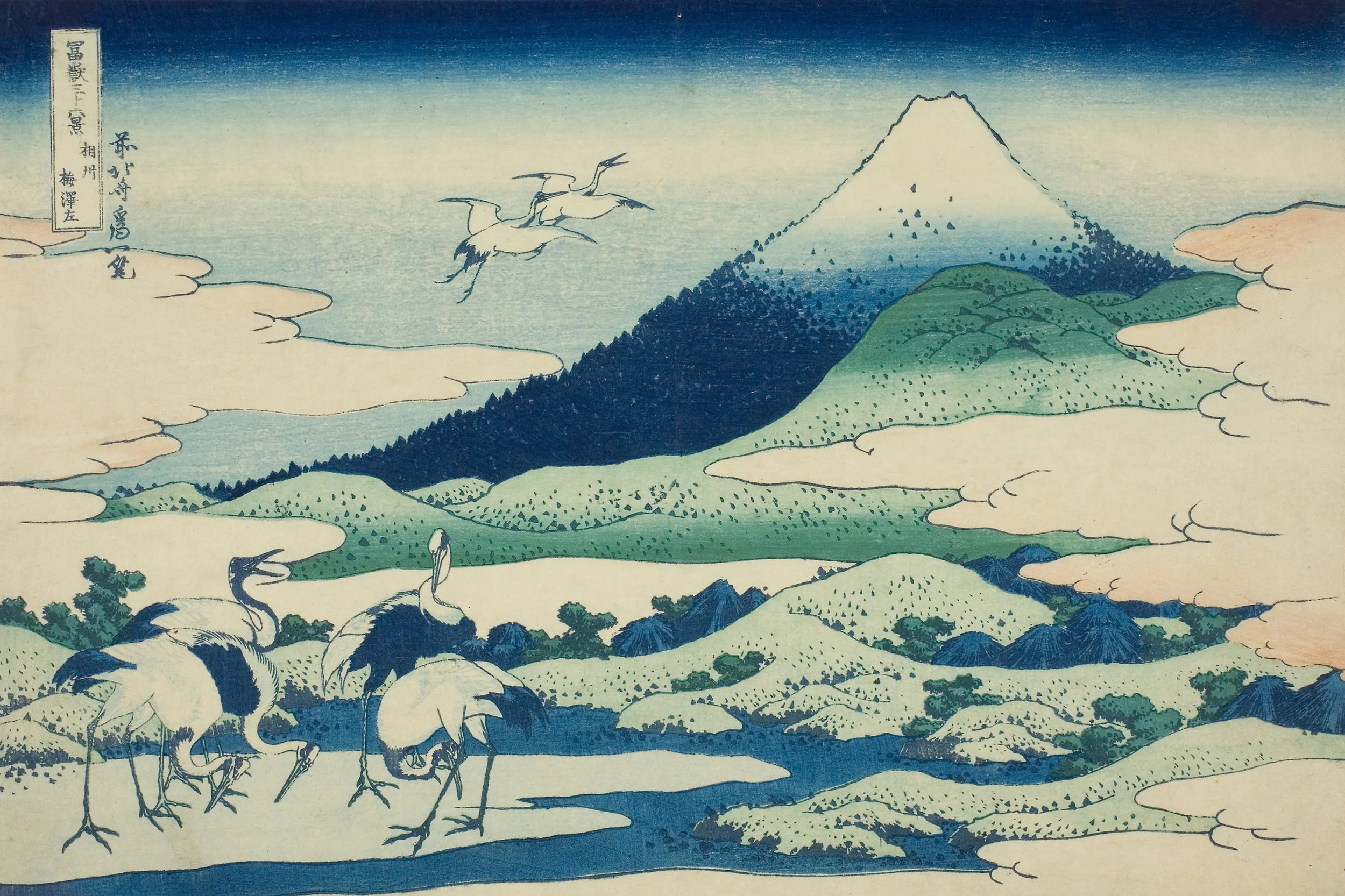19.Hongakuji Temple at Asakusa in Edo 東都浅草本願寺
Tōto Higashi Hongan-ji
Located in Nishi-Asakusa, Taitō Ward, Tokyo
This is the Asakusa branch temple of the Hongan-ji denomination of Jōdo Shinshū Buddhism.
In Kyoto, there are both Eastern and Western Hongan-ji temples.
However, Kyoto’s Eastern Hongan-ji belongs to the Ōtani branch of Shinshū,
established due to a historical schism.
Therefore, the Asakusa Hongan-ji in Tokyo, belonging to the same sect as the Western Hongan-ji,
is closer in lineage to that Kyoto temple.
The temple still exists today,
and its roof design has remained unchanged since Hokusai’s time.
From Hokusai’s perspective—
The height of the temple roof seems improbable.
There likely weren’t any such tall buildings in the area at the time.
Did he climb a fire watchtower?
He wouldn’t go to such trouble.
Hokusai could draw it regardless.
It’s obvious he wanted to echo the shape of Mount Fuji with the roofline.
But the distant fire watchtower,
the kite, and Fuji—all appear above the clouds.
Meanwhile,
the rooftops of Edo peek through from below the clouds.
This viewpoint isn’t from a fire watchtower—
it’s from an airplane.
An utterly impossible perspective.
Looking more closely:
The roof tiler is strangely small.
Everything except the main subject is treated as a supporting role.
Clouds, which appear often in Hokusai’s work,
frequently serve as erasers.
In reality, from this perspective,
Edo’s tiled rooftops would be lined up and visible.
To remove those,
he used clouds as erasers.
Anything unnecessary to show is simply erased.
He could have used pine trees in the foreground,
hiding things behind pine needles—
but Hokusai avoided composing with foreground objects.
Likely because he considered it an easy or lazy solution.
So instead, he intentionally hides with implausible clouds.
One can glimpse here the pride of “Hokusai the master of composition.”
The composition blends perspectives—
as if seen from above an airplane,
and also from a fire watchtower.
But Hokusai doesn’t care in the slightest.
The craftsmen being drawn smaller than in reality—
that’s for the same reason.
The main subject is large and detailed.
Supporting elements are simplified.
He incorporates anything that serves simplification.
Because his purpose is to convey what he wants to show.
Therefore, in Hokusai’s mind, this composition is the truth.
Hokusai’s aesthetic sensibility resides here.
10
20.Umezawa Manor in Sagami Province 相州梅澤左
Sōshū Umezawa-hidari
Mount Fuji seen from the Umezawa area of present-day Ninomiya Town, Naka District, Kanagawa Prefecture.
It is located between the Ōiso and Odawara post towns on the Tōkaidō Road,
and was once a bustling resting place.
From the depiction of cranes, the season is likely winter.
The five white birds standing are probably on ice.
Fuji and cranes—both are regarded as auspicious.
The main subjects are Mount Fuji and the cranes.
To emphasize these, could Hokusai have left the rest as pure background,
as he did in Kōshū kajikazawa?
From the location of Sōshū Umezawa-hidari, Fuji appears close and large.
It would have been unreasonable to completely ignore the middle ground.
So Hokusai adds a "sub-theme."
Try drawing a vertical line downward from the summit of Fuji.
Along that line you’ll find, from front to back:
A small land rise in the foreground
A mid-sized rise
A mountain before Fuji
And finally Mount Fuji itself
This creates a light, rhythmic progression.
The clouds—serving as erasers—
can now be understood as drawn to emphasize this rhythm.
In reality, the mountains seen from Ninomiya are far flatter.
This rhythm of similar forms is thus Hokusai’s invention.
The gaze that flows from the cranes
and the gaze that rises from the mountains
both meet at the summit of Fuji.
The composition can be reinterpreted this way:
Fuji is the focal point (“pivot”),
toward which both the cranes and the mountains direct their visual energy.
The cranes are the main theme, the mountains the sub-theme.
The cranes are a direct metaphor; the mountains, an indirect one.
The cranes represent movement; the mountains, stillness.
The cranes are on the surface; the mountains are hidden.
Two different elements
serve the same purpose.
A hidden intention.
Hokusai’s aesthetic sensibility resides here.

